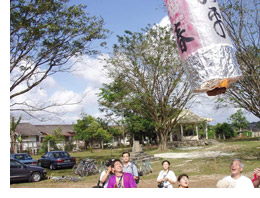 In the dawn of December 8, 1941, Imperial Japanese Army troops surprisingly landed on Malay Peninsula at Kota Bahru (the most northern part of West Malaysia today), Singola (Songkhla today) and Pattani, southern Thai, aiming to conquer Singapore. This was about one hour before bombing by Navy airplanes on Pearl Harbor, Hawaii. Defeating British units deployed in Malay Peninsula day after day, IJA reached Johor Bahru, the most southern town of the peninsula, in the end of January 1942. All-out attack started on February 8 across the Johor Strait, followed by fierce battles in Singapore, resulting in the UK troops to surrender on February 15. Lantern marches to celebrate the victory was held all over Japan.
In the dawn of December 8, 1941, Imperial Japanese Army troops surprisingly landed on Malay Peninsula at Kota Bahru (the most northern part of West Malaysia today), Singola (Songkhla today) and Pattani, southern Thai, aiming to conquer Singapore. This was about one hour before bombing by Navy airplanes on Pearl Harbor, Hawaii. Defeating British units deployed in Malay Peninsula day after day, IJA reached Johor Bahru, the most southern town of the peninsula, in the end of January 1942. All-out attack started on February 8 across the Johor Strait, followed by fierce battles in Singapore, resulting in the UK troops to surrender on February 15. Lantern marches to celebrate the victory was held all over Japan.
For three and a half years since then until Japan’s surrender, dark days continued in Shonanto, a new name of the island called by Japan. The first thing the Emperor’s military did was to massacre Chinese people. Rudely segregating “bad” Chinese from “good” ones with so-called Sook Chin process, IJA mercilessly killed selected ones.
Many of more than 100 thousands Allied prisoners of war who were detained in Changi Prison was later sent to construction sites of Thai-Burma Railway, where tens of thousands died by diseases of malaria, cholera, etc., engaging in harsh slave labor.
Post war Singapore has remarkably incarnated as a core of trade and industry. Neatly trimmed green leaves are seen elsewhere in the Garden City. Rows of silk trees make tunnel along the six lane highway from Changi International Airport to the City, on the median strip of which tropical flowers like bougainvilleas welcome visitors from abroad.
Seafood restaurants in the East Coast lure sightseers to delicious cuisines. However, this was also the area where many Chinese people were massacred here and there, and thrown into sea. Changi Beach in the proximity to the Changi Airport was one of these places of atrocity, where there is a monument commemorating the tragedy with epitaph in four languages. There are similar monuments in Sentosa island and Punggol as well.
Various other memorials and plaques remembering the war are scattered all over the island; places where IJA troops landed crossing Johor Strait, Old Ford Factory where UK troops surrendered to Lieutenant General Yamashita Tomoyuki, a city corner where Sook Chin was done, YMCA building where Kempeitai stationed and tortured those falsely detained, replica of a church for POW’s in Changi Prison, etc.
In front of the War Memorial in the city center, memorial service is held on February 15 every year, where school children, several religious leaders and others lay wreathes. Being a semi-official ceremony, relevant ambassadors including of Japan observe it, though no cabinet member of Japan has participated so far.
In 8th leg of MPPC, we will visit these places mainly by bicycles for atonement, and listen to the eye witnesses, learn history of the WWII at the sites. Will also attend the February 15 ceremony and remember those victims. Will report back realities of IJA’s invasion, in order not to repeat the tragedies. On the first 2 days of the trip, will go into Johor Bahru, Malaysia, and pay respect to Chinese people massacred at several cenotaphs.
MPPC is now inviting participants whoever agrees with our travel purposes. The fare is tentatively yen225,000 including roundtrip airfare, accommodations, all meals, transportation fees for a coach and a truck, and expenses to publish memorial pamphlet afterward, etc. Young generations are most welcome.
TAKI Hideki
Malay Peninsula Peace Cycle